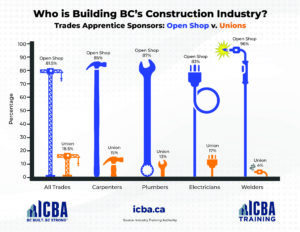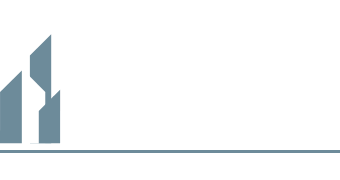Chris and Jordan break down the crushing court defeat to John Horgan’s Trans Mountain reference case; Horgan’s delays on Massey; the NDP’s pandering to their special interest groups; and the crumbling confidence of the BC business community.
Month: May 2019
OP/ED: Truth in Training vs UnionSpeak
This op-ed by ICBA President Chris Gardner first appeared in The Province newspaper on Wednesday, May 29, 2019.
 There are three kinds of lies: lies, damned lies, and statistics. Decades after Mark Twain popularized this remark, the building trades unions in B.C. have breathed new life into his observation.
There are three kinds of lies: lies, damned lies, and statistics. Decades after Mark Twain popularized this remark, the building trades unions in B.C. have breathed new life into his observation.
Only 15 per cent of B.C.’s 250,000 construction workers are affiliated with the traditional building trades unions. While the rest of the men and women in construction have moved onto more flexible models that give workers greater choice, better career options and participation in profit-sharing and bonus plans, the building trades cling to old-school hiring halls, rewarding seniority over skill, rigid rules and antiquated business practices that hurt workers and are financially unsustainable.
Desperate to turn back the clock and to justify to their members – and government – that they remain relevant, the building trades have adopted apprenticeship training as their last line of defence. Unfortunately for them, neither the facts nor the statistics back up their sanctimony.
Learning a skill and mastering a craft happens on the job working side-by-side with colleagues who have the experience and expertise to pass on to those following in their footsteps. What is learned in the classroom is enhanced and refined on the job.
It should then come as no surprise that the building trades train only 15% of the construction workforce – that’s the percentage of the workforce they represent. The remaining 85% of construction workers who are members of employee associations and progressive unions or who work for construction companies not affiliated with the building trades unions are trained in classrooms by instructors and on the job by their colleagues, just like their building trades counterparts.
In fact, statistics obtained from the Industry Training Authority (ITA) through a Freedom of Information request shows that 23,172 of the province’s 28,432 registered construction apprentices are not affiliated with any union. That means 81.5 per cent of construction apprentices are not sponsored by the building trades or any other union, including progressive ones like CLAC.
The vast majority of apprenticeship sponsorship in this province is done by Independent Contractors and Businesses Association (ICBA) and open shop companies – not the traditional building trades unions. It’s not even close.
That ICBA sponsors more construction apprentices than any other entity in B.C. is an ever-present uncomfortable reality for unions who collect millions in “training” funds from their workers.
In a recent op-ed, building trades union president Tom Sigurdson tried to downplay ICBA’s number of apprentices by cherry-picking a stat claiming that “there are more than 1,300 registered apprentices in just two of our union trade schools alone: the Electrical Joint Training Committee and the Piping Industry College.”
But the ITA’s numbers show that ICBA and non-union companies have thousands more apprentices in those trades. Combined, ICBA and non-union companies sponsor 10,329 construction and industrial electrician, plumber, sprinkler fitter, steamfitter-pipefitter and welder apprentices. The unions train 2,073. That’s a margin of 5 to 1 for the open shop.
And we’re not certain those union-trained apprentices are even staying in B.C. The Piping Industry College is advertising a program to certify Canadian union plumbers to work (and move to) New Zealand. That’s right: the same unions who claim B.C. has a huge worker shortage and constantly fear-monger about foreign workers taking jobs from British Columbians is shipping B.C.-trained plumbers halfway around the world. And it’s not just plumbers – the first group of B.C. union electricians started working in New Zealand in March.
All of this makes the NDP Government’s move to building trades union-only monopolies on major taxpayer-funded projects so offensive. By forcing all workers on the Pattullo Bridge to join a building trades union and to become an employee of a new crown corporation is a sop to the building trades unions who happened to have donated $2.5 million to the NDP over the past few elections.
Money talks, folks. This gift to the friends and insiders of the NDP Government is not about training or hiring more young people or providing more opportunities for women – indeed, the statistics prove non-union apprenticeship is thriving. It’s money at the heart of one of the most offensive backroom deals to come out of Victoria in decades.
NEWS RELEASE – FOI Reveals That On Apprentices, Open Shop Out-sponsoring Unions 4 to 1
 BURNABY—Non-union construction companies sponsor four times as many trades apprentices as unions in British Columbia, according to documents obtained from the provincial government’s Industry Training Authority through a Freedom of Information request.
BURNABY—Non-union construction companies sponsor four times as many trades apprentices as unions in British Columbia, according to documents obtained from the provincial government’s Industry Training Authority through a Freedom of Information request.
The documents show that 23,172 of the province’s 28,432 registered construction apprentices – meaning 81.5 per cent of B.C.’s construction apprentices are sponsored by open shop companies, not unions.
“The numbers thoroughly debunk the building trades unions’ myth that only they train construction apprentices,” said Chris Gardner, president of the Independent Contractors and Businesses Association (ICBA), which represents more than 2,100 of these open shop companies. “In fact, it’s open shop companies which do the heavy lifting of recruiting, training, equipping and sponsoring trades apprentices in this province.”
While ICBA is proud to be the single largest sponsor of trades apprentices in B.C., with more than 1,100 registered, this is just a slice of the more than 23,000 sponsored by non-union companies.
In many trades, the percentage of open shop apprentices is even higher:
- Welders – 96% open shop (777 apprentices); 4% union (29)
- Plumbers – 87% open shop (2,892); 13% union (438)
- Carpenters – 85% open shop (4,437); 15% union (801)
- Electricians – 83% open shop (6,150); 17% union (1,301)
“Over the past 35 years, the building trades unions have lost market share, lost any wage and benefit advantage they used to have, and alienated generations of B.C. construction workers,” said Gardner. “Rather than truly represent the best interests of workers, the building trades unions are focused on saving their failing business model and are relying on NDP government-ordered union monopolies on taxpayer-funded projects in a bid to remain relevant.”
Gardner noted that the building trades unions are advertising a program to certify Canadian union plumbers to work (and move to) New Zealand. And the same with union electricians: the first group of B.C. union electricians started working in New Zealand in March.
“The same unions who claim B.C. has a huge worker shortage and constantly fear-monger about foreign workers taking jobs from British Columbians is shipping B.C.-trained plumbers and electricians halfway around the world,” said Gardner. But where the building trades unions have failed B.C. workers and the construction industry, ICBA, open shop and progressive labour organizations have more than picked up the slack, Gardner said.
“Workers want choice, flexibility and opportunities to grow and succeed, that’s why non-building trades construction contractors are growing,” said Gardner. “It’s hard to find innovation and new approaches to work in 1970s style union hiring halls where union organizers tell you when, where or even if you can go to work in the morning.”
Click HERE and HERE to read the FOI documents from the Industry Training Authority. (Microsoft Excel spreadsheets)
Click HERE for an infographic illustrating the statistics above.
Click HERE to read an op-ed from Chris Gardner on these trends. This op-ed is available for media outlets to publish, free-of-charge.
TRAINING THURSDAY: Strategic and Cost-Effective Step Code Compliance
Do you have a strategy in place for achieving your project Step Code targets cost effectively? Let us help! Our Strategic and Cost-Effective Step Code Compliance half-day workshop is in Burnaby June 12.
This half-day course will not only enhance your comprehension of the Step Code for Part 9 buildings, it will enable you to prioritize the energy conservation measures you consider for your projects based on construction cost and energy impact.
Here’s what’s covered:
- Understand the Step Code performance targets, and to what extent their achievement is influenced by:
-
- Building envelope components (windows, wall assemblies, etc.)
- Building airtightness
- HVAC equipment selections
- Improve your ability to:
-
- Facilitate an efficient design and documentation cycle, from acquisition of development permit through to submission of the building permit application
- Ensure design details, particularly related to airtightness, are successfully implemented in the field
- Learn to predict which Step Code projects will be especially challenging
- Be able to identify and rank the most cost effective measures for achieving Step Code targets, and estimate corresponding cost premiums
- Expand your knowledge about high efficiency mechanical systems and their relevance to Step Code, including:
-
- Common and not-so-common options for hot water heating, space conditioning and ventilation
- Proper application, selection, and installation of equipment
Plus, you’ll earn 4 Group A CPD Points from BC Housing! Register for this or any of our other upcoming courses at www.icba.ca/courses.
